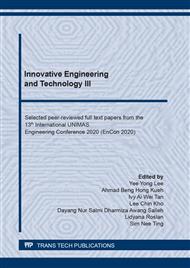p.45
p.53
p.63
p.73
p.88
p.94
p.103
p.110
p.124
Strength of Concrete with Recycled Manganese Slag
Abstract:
This paper studies the effect of replacing coarse aggregates with manganese slag on the mechanical properties of concrete. Air-cooled granulated manganese slag was used. The control sample was designed to achieve concrete strength of 30 MPa at 28 days. Tests were conducted on five different compositions of concrete having manganese slag to coarse aggregates ratios of 0, 0.2, 0.3, 0.4, and 1. The specimens were tested at 7, 14, and 28 days for their compressive and flexural strength. Test results revealed that all manganese slag concrete specimens had improved compressive and flexural strength. The maximum compressive strength achieved was 43.54 MPa, increased by 16% of the control specimen and the maximum flexural strength achieved was 4.50 MPa, increased by 22% of the control specimen. Both results were obtained in concrete with 0.4 manganese slag to coarse aggregate ratio. Besides, the study also showed that it might be possible to substitute all coarse aggregates in concrete with manganese slag without any loss in strength. However, it was observed that the concrete workability decreased when manganese slag was added. Nonetheless, this could be corrected using superplasticizer.
Info:
Periodical:
Pages:
88-93
Citation:
Online since:
May 2021
Authors:
Price:
Сopyright:
© 2021 Trans Tech Publications Ltd. All Rights Reserved
Share:
Citation:


